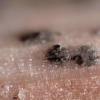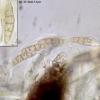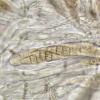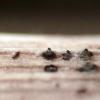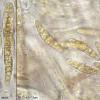
21-12-2025 09:32
Hello.A tiny ascomycete found embedded in wood in

21-12-2025 21:32
Pol DebaenstHello, Garden, Burgweg 19, Veurne, BelgiumOn 10/1

22-12-2025 23:38
Patrice TANCHAUDBonsoir, récolte sur un mur en pierre, apothéci

22-12-2025 00:47
Patrice TANCHAUDBonsoir, récolte à proximité du milieu dunaire

21-12-2025 21:40
Isabelle CharissouBonjour, j'aimerais connaitre les références de

20-12-2025 23:08
Patrice TANCHAUDBonsoir, récolte sur sol sablonneux dans l'arri�
Phaeosphaeria subgenus Vagispora
Björn Wergen,
22-02-2012 20:43
 Hi,
Hi,I have found a Phaeosphaeria on dead Poaceae stems with 5septated, 27-30x6-7,5µm spores. I have tried Shoemaker&Babcock and Leuchtmann and come to Phaeosphaeria larseniana, which has smaller spores (Shoemaker: 20-27x7-9µm). I am sure it is a species of subgenus Vagispora. Perhaps someone can help :)
I did not see a sheath. The spores are smooth.
regards,
björn
-------------------
I think it can be P. vagans with no longitudinal septa. P. vagans seems to be a very variable specimen...
Björn Wergen,
23-02-2012 14:56

Re : Phaeosphaeria subgenus Vagispora
Here are some new photos, I am sure it is a dicote substrate, the fb are about 80-150µm broad and have a small ostiolus. Spores are permanently (I have 3 collections now) around 28-32x5,5-7,5µm, quiet too big and too pale for P. luctuosa, which has a similar length. Perhaps this photos will help by identification.
The interesting thing is that the spores have obviously 5 septa in most cases, but inside asci there are many with more septa, I have counted up to 9 septa in some cases). There are no longitudinal septa.
regards,
björn
btw: I am always looking for literature about Phaeosphaeria, Leptosphaeria and allies (Massariosphaeria, Kalmusia, Paraphaeosphaeria etc.).
The interesting thing is that the spores have obviously 5 septa in most cases, but inside asci there are many with more septa, I have counted up to 9 septa in some cases). There are no longitudinal septa.
regards,
björn
btw: I am always looking for literature about Phaeosphaeria, Leptosphaeria and allies (Massariosphaeria, Kalmusia, Paraphaeosphaeria etc.).
